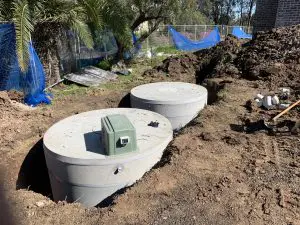Maintaining a healthy septic system is essential for the smooth operation of your household’s wastewater management. However, like any other component of your home, septic tanks can encounter issues over time. From clogs and leaks to drain field problems, understanding these common septic tank problems and implementing preventive measures is key to avoiding emergencies and prolonging the lifespan of your system. In this comprehensive guide, we’ll explore the typical issues homeowners may encounter with their septic tanks and provide practical tips for prevention.
Understanding Common Septic Tank Problems
Clogs: One of the most frequent issues homeowners face with their septic tanks is clogging. Clogs can occur in various parts of the system, including pipes, the tank itself, and the drain field. Common culprits for clogs include flushing non-biodegradable items such as paper towels, sanitary products, grease, and excessive use of household chemicals.
Leaks: Leaks in a septic tank can lead to groundwater contamination and environmental hazards. Leaks often occur due to corrosion, damage to the tank structure, or improper installation. Signs of a leak may include foul odors around the tank area, lush grass growth over the drain field, or pooling water.
Drain Field Problems: The drain field plays a crucial role in the septic system by filtering and dispersing wastewater into the soil. When the drain field becomes saturated or clogged, it can result in sewage backup, foul odors, and standing water on the property. Drain field issues can stem from excessive water usage, compaction of soil, or root intrusion.

Practical Tips for Prevention
Practice Proper Waste Disposal: To prevent clogs in your septic system, it’s essential to only flush biodegradable items down the toilet. Avoid flushing paper towels, diapers, sanitary products, cigarette butts, grease, and other non-biodegradable materials. Additionally, limit the use of household chemicals, as they can disrupt the natural balance of bacteria in the tank.
Conserve Water: Excessive water usage can overload your septic system and lead to drain field problems. Implement water-saving practices such as fixing leaks promptly, installing low-flow fixtures, taking shorter showers, and running full loads of laundry and dishes. By conserving water, you reduce the strain on your septic tank and prolong its lifespan.
Schedule Regular Maintenance: Regular maintenance is crucial for keeping your septic system in top condition. Schedule routine inspections and pumping with a qualified septic tank professional to prevent issues before they escalate. Pumping frequency depends on factors such as household size, usage, and tank capacity, so consult with a professional to determine the appropriate schedule for your system.
Protect the Drain Field: Take measures to protect the drain field from damage and saturation. Avoid parking vehicles or heavy equipment over the drain field, as this can compact the soil and inhibit proper wastewater absorption. Additionally, refrain from planting trees or shrubs near the drain field to prevent root intrusion.
Be Mindful of What Goes Down the Drain: Be mindful of what you pour down the drains in your home. Avoid dumping cooking oils, grease, coffee grounds, and food scraps down the kitchen sink, as these substances can accumulate in the septic tank and cause clogs. Use a strainer in the kitchen sink to catch solids and dispose of them in the trash.
By understanding the common septic tank problems and implementing preventive measures, homeowners can avoid emergencies and prolong the lifespan of their septic systems. Practicing proper waste disposal, conserving water, scheduling regular maintenance, protecting the drain field, and being mindful of what goes down the drain are essential steps in maintaining a healthy septic system. Remember, proactive maintenance is key to preventing costly repairs and ensuring the smooth operation of your septic tank for years to come.
Related Posts
- How do I find Septic Tanks near me?
- How to care for your septic tank system
- How do aerated wastewater treatment systems work
- Choosing the Right Septic Tank Size for Your Sydney Property
- What happens to all the waste that’s pumped from septic tanks?
- How does Wastewater and Greywater differ?
- Septic Tank Inspections: Why They’re Crucial for Homebuyers
- Smart Investing: How Regular Servicing Saves You Money in the Long Run




